Some art doesn’t try to look like anything real. Just shapes, lines, and colors that somehow still grab your attention.
That’s geometric abstraction. It uses basic shapes and bold colors to create art that packs a punch and gets you thinking about what it could mean.
No flowers, faces, or landscapes here. Just triangles, circles, squares, and lines arranged in ways that make you look twice. Pure form. Math-based design.
What Is Geometric Abstraction?
- Geometric abstraction is an art style that emerged in the early 20th century.
- It uses simple geometric shapes (triangles, circles, lines, etc.) arranged together.
- It usually uses bold, flat colors—often primary colors (red, yellow, blue).
- It’s a non-representational form of art, meaning it doesn’t try to portray recognizable things.
- It was influenced by modern art movements like Cubism and later influenced various art movements like minimalism and op art.
Where Did Geometric Abstraction Come From?
Geometric abstraction burst onto the art world in the early 1900s. It was a time when everything was changing—how people thought, what they believed, even how they moved around. There were breakthroughs in science. Math. Philosophy.
Artists wanted something new. Something that broke all the rules.
They stepped away from painting things as they appeared. Instead, they used simple forms to create a different kind of art.
No more stories or feelings in their work. Just pure shapes and colors arranged with careful thought.
From Cubism to Pure Shapes
It all started with Cubism around 1907. Artists like Pablo Picasso and Georges Braque broke objects into blocky, geometric parts.
Russian artists pushed this idea even further. Constructivists tried to find the purest form of abstract art, stripping it of any reference to the real world. How far could abstract art be pushed before it stopped being art?
As an example, Kazimir Malevich created Suprematism with works like Black Square (1915). Just a black square on a white background. Simple but shocking at the time.
Finding Order in De Stijl
In the Netherlands, Piet Mondrian and Theo van Doesburg started the De Stijl movement in 1917. They used only straight lines, squares, and primary colors, plus black and white.
Order, harmony, and balance through precise lines and restricted color palettes. De Stijl is the perfect example of geometric abstraction’s emphasis on structure.
Mondrian’s famous grid paintings with red, blue, yellow, black, and white boxes became icons of abstract art.
Spreading Through the Bauhaus

The Bauhaus school in Germany (started in 1919 by Walter Gropius) took geometric forms beyond just painting. They applied these simple shapes to buildings, furniture, and even typefaces.
Teachers like Josef Albers explored how colors work together in geometric patterns. László Moholy-Nagy applied geometric abstraction to photography and industrial design.
New Life After World War II
After World War II, geometric abstraction kept evolving. Artists like Frank Stella, Victor Vasarely, and Bridget Riley added new twists. They created optical illusions with precision-based designs.
The style also took off in Latin America, with artists like Carlos Cruz-Diez and Jesús Rafael Soto adding movement to geometric shapes. This kinetic art requires viewers to physically move around to get the full effect.
By the 1960s, these forms influenced Minimalism. Artists like Donald Judd used pure geometric forms with no decoration.
Today, geometric abstraction shapes everything from website design to furniture. Its clean forms and visual balance never go out of style.
What Makes Geometric Abstraction Stand Out?
Geometric abstraction has clear features that make it easy to spot. Instead of showing real-world things, artists focus on shape, form, and how elements look together.
Simple Shapes, Not Real Things
Artists use circles, rectangles, triangles, and straight lines. They arrange these in patterns that create visual interest. They can be structured and grid-like or dynamic and asymmetrical.
No people, landscapes, or objects appear in pure geometric abstraction. The shapes themselves are the star of the show.
There is no storytelling. No symbolism. No narrative. It’s exactly what it appears to be. Nothing more. Nothing less.
Bold, Clear Colors
Many geometric artists stick to a simple color palette. They often restrict themselves to just using just red, blue, and yellow (plus black and white).
Some artists, like those making Op Art, use contrasting colors that seem to vibrate when placed next to each other.
These simple color schemes make geometric prints versatile in home design. They can complement your existing color palette or add a perfect pop of color to neutral spaces.
Clean and Precise
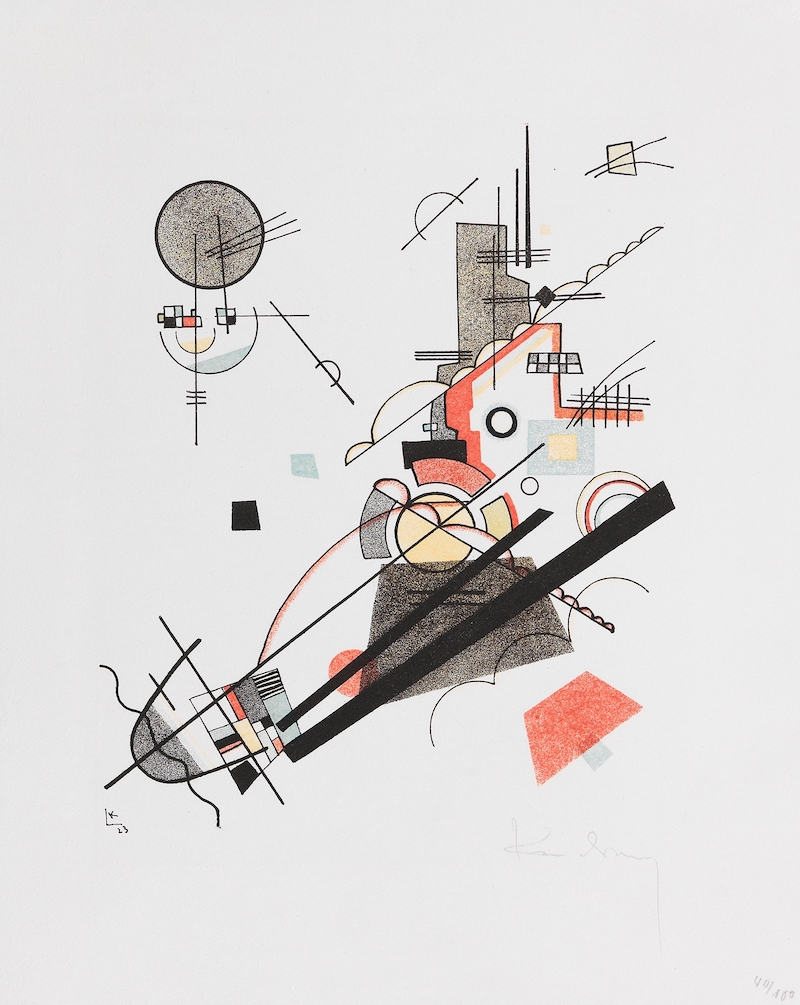
Wassily Kandinsky’s Fröhlicher Aufstieg (1923)
Most geometric abstraction looks carefully planned and precisely made. Artists focus on balance, symmetry, and clean lines. Math and logic are key concepts.
Movements like De Stijl and Hard-Edge Painting created works with razor-sharp edges and flat areas of color.
These bold, clean compositions create instant focal points for decorating your home. A geometric print can anchor a room with its strong visual presence.
Flat, Not 3D
Many geometric works stay flat on purpose. Artists avoid creating the illusion of depth or perspective.
This reminds viewers they’re looking at a piece of art, not a window into another world. It’s an object to take at face value.
The intentional flatness creates a modern feel that works well in contemporary interiors.
Inspired by Math and Science
Many of these artists drew inspiration from science, math formulas, and architectural blueprints.
They wanted to create a visual language anyone could understand, regardless of background or culture. Math is a universal language, so they applied math to art.
These spatial relationships between forms give the artwork a sense of order that feels satisfying to the eye.
Playing with Your Eyes

Some branches, like Op Art, use intricate geometric patterns to trick your eyes. They create illusions of movement or depth.
Artists like Victor Vasarely and Bridget Riley made works that seem to pulse or shift as you look at them.
All these features together helped geometric abstraction become one of modern art’s most influential styles, reaching far beyond painting into many parts of our daily lives.
Artists Who Shaped Geometric Abstraction
Several key abstract artists defined this style with their groundbreaking work in the art world.
Piet Mondrian: Master of the Grid
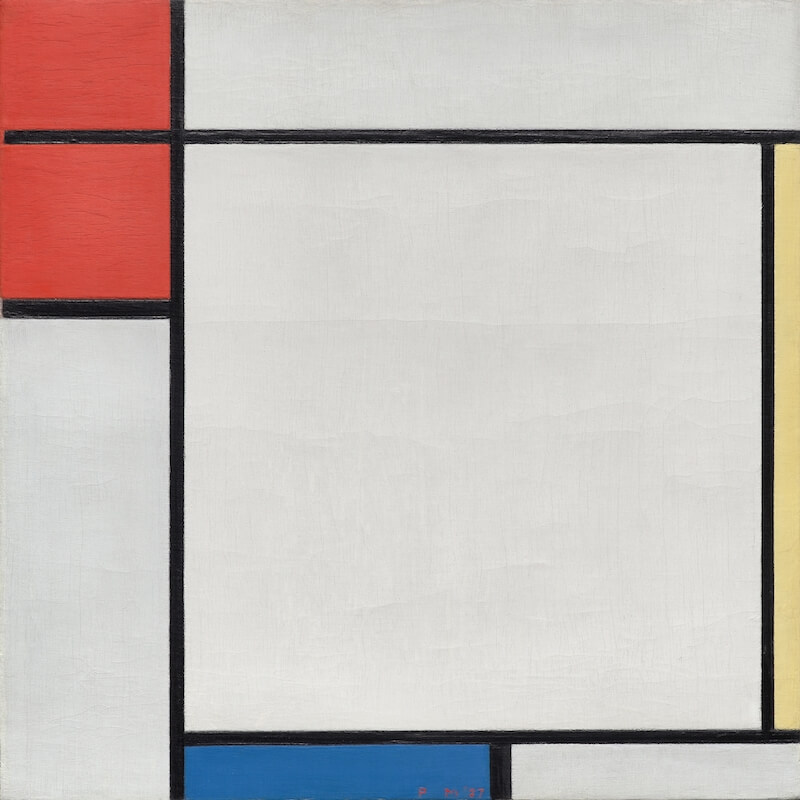
Piet Mondrian’s Composition with Red, Yellow, and Blue (1927)
Dutch artist Piet Mondrian led the De Stijl movement, using only straight lines and primary colors to create a universal visual language. Some of Theo van Doesburg’s art looks similar but makes it more dynamic by using diagonals.
Famous Works:
- Composition with Red, Blue, and Yellow (1930) – His signature grid painting
- Broadway Boogie Woogie (1942–43) – Inspired by New York City’s energy
- Composition II in Red, Blue, and Yellow (1930) – Perfect balance of simple forms
His distinctive abstract art style influenced everything from fashion to furniture design.
Josef Albers: The Color Expert
Bauhaus teacher Josef Albers explored how contrasting colors interact with each other in geometric compositions. The same color could look different in different pieces just because of what he chose to pair it with.
Famous Works:
- Homage to the Square series – Nested squares in different colors
- Interaction of Color (1963) – His famous book explaining color theory
- Study for Homage to the Square (1970) – Part of his decades-long exploration
Albers showed how the same geometric shapes could create entirely different feelings just by changing their colors.
Victor Vasarely: Creating Visual Tricks
Victor Vasarely pioneered Op Art, using geometric patterns to create optical illusions and visual movement.
Famous Works:
- Zebra (1937) – An early example; black-and-white zebras creating 3D effects and implied lines
- Vega-Nor (1969) – A grid that seems to bulge outward from the canvas
- Banya (1964) – A pattern of complementary colors that seems to vibrate and move
His paintings pushed the limits of what geometric forms could do to our perception.
Kazimir Malevich: Bold Simplicity
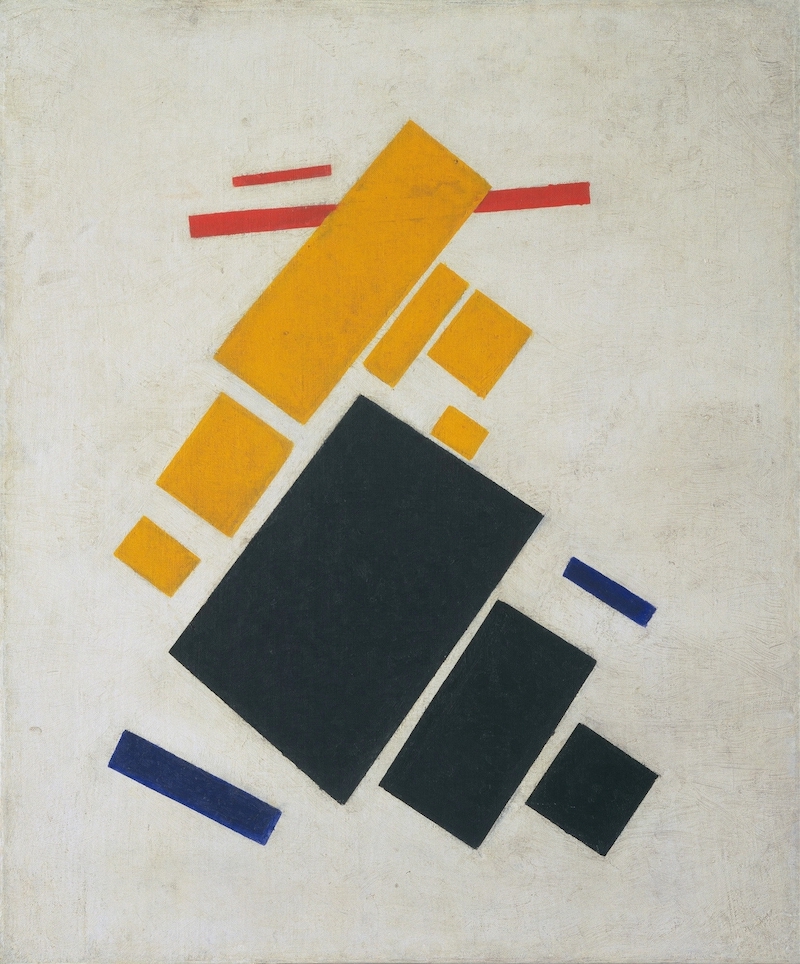
Kazimir Malevich’s Suprematist Composition: Airplane Flying (1915)
Russian avant-garde artist Kazimir Malevich founded Suprematism, reducing art to its most basic elements. He was looking for the “zero degree:” the point at which art stopped being art.
Famous Works:
- Black Square (1915) – Just a black square on white, yet revolutionary
- White on White (1918) – A white square on a slightly different white background, with significant political context
- Suprematist Composition: Airplane Flying (1915) – Floating geometric shapes arranged to look like they’re in motion
Other artists worked to expand our perception of art. Suprematists worked to define the boundaries.
Bridget Riley: Queen of Op Art
British artist Bridget Riley became famous for creating eye-dazzling patterns that seem to shift as you look at them. She’s one of the most well-known Op Art artists.
Famous Works:
- Movement in Squares (1961) – Black and white squares creating wave-like motion
- Blaze I (1962) – A spiral pattern that seems to spin on the canvas
- Cataract 3 (1967) – Colorful wavy lines that appear to ripple
Riley’s fine art explored how geometric patterns could create a sense of movement without actually moving.
Frank Stella: Bold and Sharp
American artist and sculptor Frank Stella led Hard-Edge Painting, using sharp lines and flat colors in geometric compositions. Minimalist, yet bold. He became a major player in postwar abstract art.
Famous Works:
- Die Fahne Hoch! (1959) – Bold black stripes on white canvas
- Harran II (1967) – Colorful, curved bands forming circular patterns
- Hyena Stomp (1962) – Bright colors arranged in geometric patterns
Stella helped push abstraction forward after the Abstract Expressionist movement.
Carlos Cruz-Diez: Color in Motion
Venezuelan artist Carlos Cruz-Diez explored how color changes when we move around it. His kinetic art shifts and transforms as viewers walk past.
Think of those holographic cards that change when you tilt them. Cruz-Diez did that with art.
Famous Works:
- Physichromie No. 113 (1963) – Colors change depending on where you stand
- Chromosaturation (1965) – Rooms filled with colored light that mix and blend
- Induction Chromatique (1963) – Shows how nearby colors affect each other
His work blurs the line between art and science, making geometric forms feel alive.
Wassily Kandinsky: Finding Feeling in Shapes
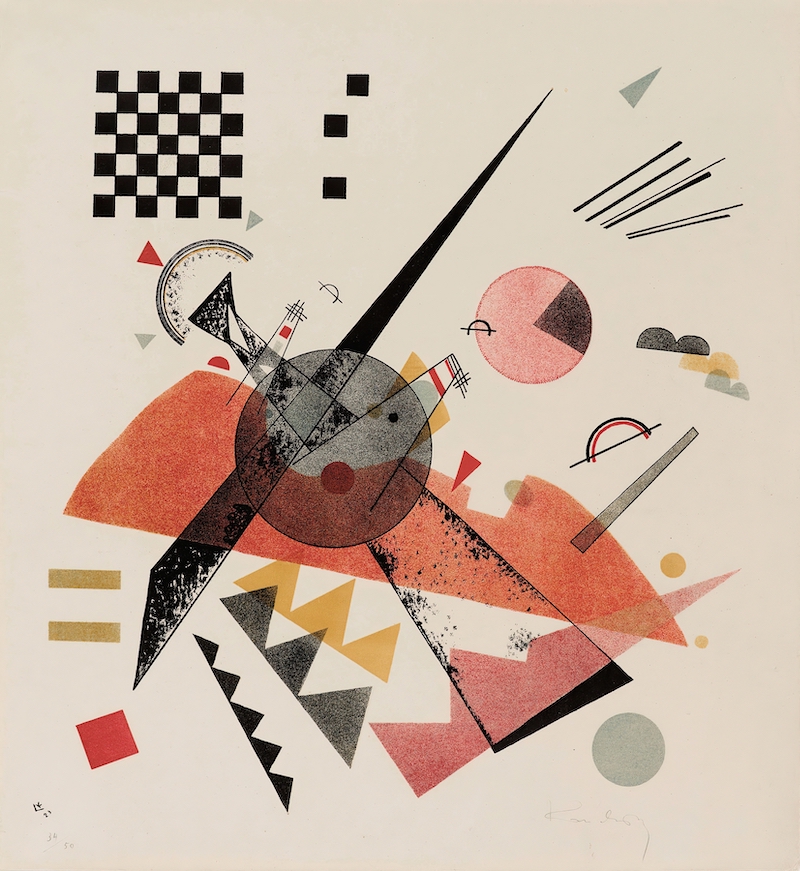
Wassily Kandinsky’s Orange (1923)
Kandinsky started with more expressive work (he’s more associated with Abstract Expressionism), but his time at the Bauhaus led him to geometric forms.
He believed shapes and colors could speak to your feelings. A triangle might feel different than a circle. Blue might feel different than red.
Famous Works:
- Composition VIII (1923) – A lively mix of circles, lines, and triangles. This work was his transition to geometric abstraction
- Several Circles (1926) – Overlapping circular forms on a black background
- On White II (1923) – Geometric elements balanced against white space
Kandinsky bridges the gap between emotional and mathematical approaches to abstraction.
Women Artists in Geometric Abstraction
While often overlooked in traditional notions of art history, women artists made significant contributions to geometric abstraction.
Carmen Herrera worked for decades before receiving recognition for her crisp, minimal geometric paintings in her 90s.
Lygia Clark and Lygia Pape, Brazilian artists, created innovative geometric works that challenged the boundaries between art and life.
Their contributions helped shape how we understand abstraction and geometric forms today.
How Geometric Abstraction Changed Art and Design
Geometric abstraction didn’t stay contained in paintings. Its ideas spread to change how we design almost everything in the contemporary art world.
Beyond Paintings: New Art Movements
Geometric abstraction led to several important movements:
- Minimalism took geometry to extreme simplicity with artists like Donald Judd and Ellsworth Kelly.
- Op Art created visual illusions with geometric patterns in the works of Bridget Riley.
- Hard-Edge Painting pushed geometry to new precision with artists like Frank Stella.
Today’s contemporary art often uses geometric principles in new ways with technology. Digital art, interactive art, and art installations like to play with these concepts.
Changing How We Build
The clean lines and bold geometric shapes changed architecture forever:
- Bauhaus buildings by Walter Gropius and Ludwig Mies van der Rohe used simple geometric forms.
- De Stijl architecture like the Rietveld Schröder House applied geometry to living spaces and furniture.
- Contemporary architecture often uses bold, angular shapes inspired by geometric abstraction.
Making Better Designs
Graphic designers embraced geometric abstraction to communicate clearly:
- New typefaces came from the Bauhaus with clean, geometric letters. Like the sans-serif you’re reading now!
- Swiss Design used grids and clean layouts for posters and books. It’s called the International Typographic Style.
- Modern logos for companies like Google and Mastercard use simple geometric shapes.
Decorative Motifs in Everyday Objects
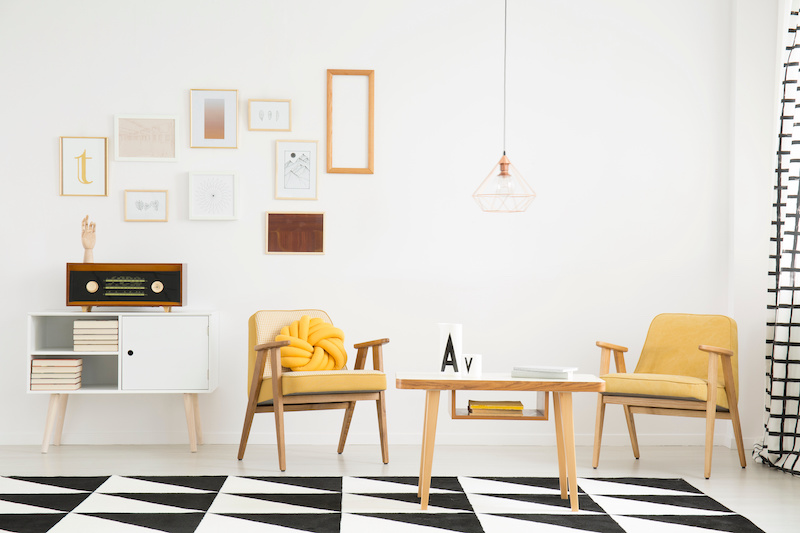
Geometric forms transformed decorative motifs in everything from textiles to ceramics:
- Furniture became sleek and simple, following geometric principles. You can see this in designs by Marcel Breuer and Le Corbusier.
- Home goods from plates to pillows featured bold geometric patterns.
- Fashion embraced geometry, from Yves Saint Laurent’s Mondrian dress to today’s graphic prints.
- Flat User Interface Design like Google’s Material Design uses geometric abstraction principles.
With digital tools, geometric abstraction finds new life in different materials and virtual spaces.
The Lasting Power of Geometric Abstraction
Geometric abstraction changed art by focusing on pure form instead of copying reality. Using basic shapes and careful design, artists created a visual language that continues to influence the avant-garde.
From Mondrian’s colorful grids to Malevich’s bold black square, these artists opened doors to new ways of thinking about art. Their early works laid the groundwork for many styles that followed.
Today, geometric abstraction lives on in everything from website layouts to furniture design. It shows that sometimes the simplest shapes can express the most powerful ideas.
Adding geometric abstract art to your walls connects your space to this influential movement. Whether you choose bold primary colors or subtle monochromatic pieces, these works bring the power of pure form into everyday living.
Try it in your space. Simple shapes. Bold impact.




